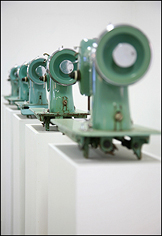![]()
Ala Younis
Opening: February 15, at 20:00 h.
Dates: February 16, - June 10, 2018
Space: South Cloister
From a socio-political perspective, Jordanian artist Ala
Younis (b. Kuwait, 1974, lives in Amman) investigates different
narratives that have been used to construct diverse visual, intellectual
and emotional images of the Near East. Her attention is focused
on, but not limited to, two particular geographical and cultural
contexts: Egypt and Iraq.
This spatial framework is further delimited by a specific time period, beginning with the aftermath of the 1948 war, the first in the long, unresolved Arab-Israeli conflict, which gave rise to historic national processes in the 1950s where ideas of social and political modernization were accompanied by the quest for a social, Pan-Arab identity. That quest materialized in international organizations and complex ties of alliance, rivalry and relations among Near Eastern countries and between them and the Soviet Union, as well as the dialectics of confrontation that characterized the Cold War with the Western nations and Israel.
However, war and conflict are not the central themes of Ala Younis’s work -with the exception of her Tin Soldiers (2010-2011)- for she prefers to explore other issues that permeate and become entrenched in the cultural bedrock once they have been emphatically expounded by the political authorities.
Occasionally alternating between the roles of researcher, curator and artist, Ala Younis’s approach to different case studies that typify this geopolitical hotspot not only offers insight and fresh perspectives -alternatives to those responsible for the stereotypical Western perception of the region- but also invites a critical reflection on the orientalizing lens inherited from colonialism.Comparing and contrasting ideals and truths in a subtle mythology, her artistic projects reveal the contradictions and longings that power and historic fables have established in the collective imagination.
The solo exhibition at the CAAC features a
considerable number of the projects she has produced over the last
10 years, from the earliest, titled Nefertiti (2008), which
examines the modernization processes that characterized the Middle
East in the 1950s and 60s from a feminist perspective, to her latest
creation, made specifically for this show in collaboration with
the Seville University School of Architecture. In fact, the architecture,
plans for change, visionary political leaders and ideological forces—both
forward and backward-looking—involved in grand schemes of
power are the pillars underpinning this exhibition of works that
delve into the tradition of artistic and historical modernization
and its reiterated failures.
ADDITIONAL DOCUMENTATION |


